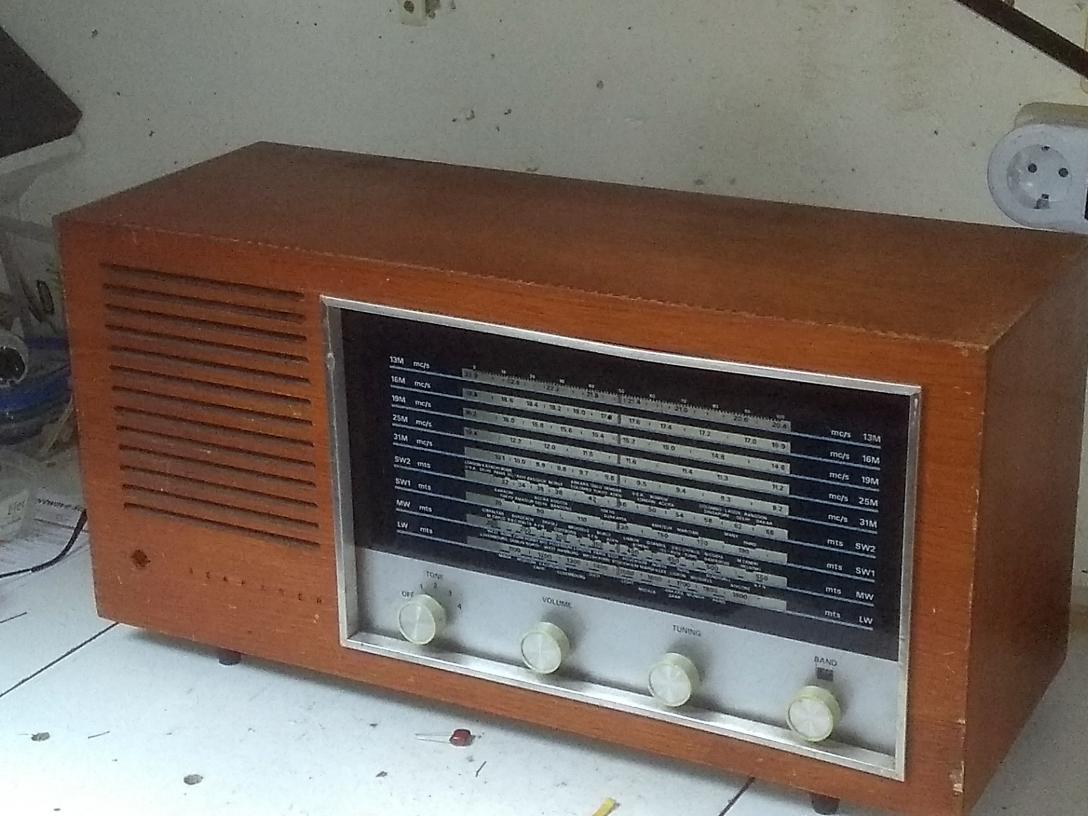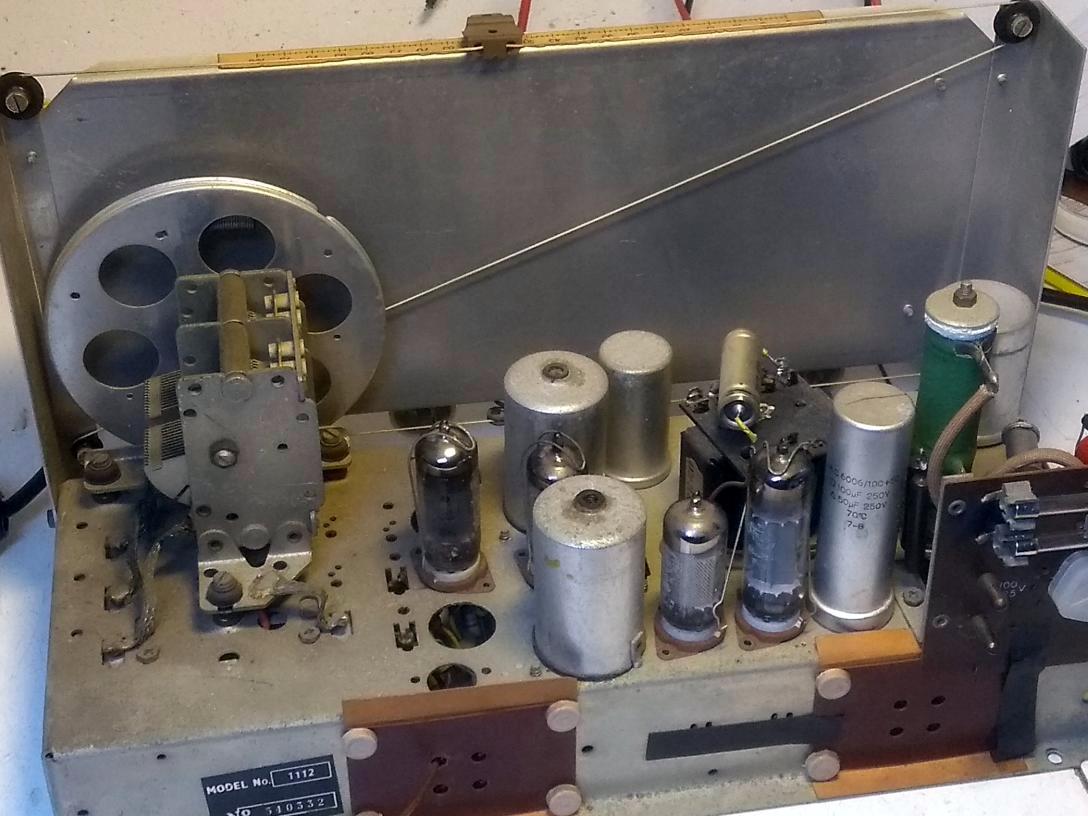 The same chassis was also available in different cabinets and under different brands, like Ekco Mariner U834, Pye 3042, and Pye 3017. Some models have Rimlock tubes. A list on thecodemachine.co.uk claims it is from 1963.
The same chassis was also available in different cabinets and under different brands, like Ekco Mariner U834, Pye 3042, and Pye 3017. Some models have Rimlock tubes. A list on thecodemachine.co.uk claims it is from 1963.

590
Item nr.

Shortwave delight with nine AM bands
| Production | England, 1963. |
|---|---|
| Bands | LW (143-286kHz), MW (530-1529kHz), SW1 (1477-4554kHz), SW2 (4402-9971kHz), 31m (9149-10107kHz), 25m (11125-12297kHz), 19m (14562-16106kHz), 16m (16860- 18649kHz), 13m (20387-22817kHz); IF is 470kHz. |
| Tubes | UCH81 (Osc./Mix), UF89 (IF amp), UBC81 (det./AF amp), UL84 (output). |
| Semi- conductors | Metal rectifier. |
| Cabinet | Wood. Size 56x29x22cm. Weight 7.4kg. |
| Power | ACDC 230V@30W. |
| Documents | See RadioMuseum.org. |
 with this set covering all major AM broadcasts bands. Most bands are spread out very nicely, the most difficult band to tune being the "Shortwave 2" where the 60m, 49m, and 41m bands are cramped upon one scale.
with this set covering all major AM broadcasts bands. Most bands are spread out very nicely, the most difficult band to tune being the "Shortwave 2" where the 60m, 49m, and 41m bands are cramped upon one scale.  The same chassis was also available in different cabinets and under different brands, like Ekco Mariner U834, Pye 3042, and Pye 3017. Some models have Rimlock tubes. A list on thecodemachine.co.uk claims it is from 1963.
The same chassis was also available in different cabinets and under different brands, like Ekco Mariner U834, Pye 3042, and Pye 3017. Some models have Rimlock tubes. A list on thecodemachine.co.uk claims it is from 1963.
| Obtained | 11/2023 from Marjanie through Marktplaats; sn=540332. |
|---|---|
| Condition | 7. |
| Value (est.) | 22€. |
| Sound sample | PLAY SOUND Radio Akenzo from Balkbrug announcement at 6275kHz. The band 6200 - 6300 kHz is used as the 48m Pirate Band. |
 The radio came in complete (almost, but with a missing pilot light). On the chassis, the four (not five!) tubes are easily recognised, and between them the two IF cans, the tuning capacitor, and output transformer. On the right you find the big green dropping resistor. The radio has three aluminium cans with smoothing capacitors.
The radio came in complete (almost, but with a missing pilot light). On the chassis, the four (not five!) tubes are easily recognised, and between them the two IF cans, the tuning capacitor, and output transformer. On the right you find the big green dropping resistor. The radio has three aluminium cans with smoothing capacitors.  After opening it, I found the power switch non functional, due to some broken lever. As a repair, I installed a volume pot with (double pole) switch.
After opening it, I found the power switch non functional, due to some broken lever. As a repair, I installed a volume pot with (double pole) switch.
To my surprise I discovered all mustard-capacitors; I suspect these not to be original. All bands function and receive well. As a downside, the radio is rather noisy; it has an uncomfortable level of hum.
To make the Seafarer more suitable for Shortwave DX-ing, I installed several modifications. First, in the heater chain I replaced the (defective) ballast resistor by a capacitor, and the 19V bulb by a 6V, to reduce power consumption. Second, the Pye has a pilot light but no illuminated dial, and neither any signal strength or tuning indicator.  I placed four green LEDs behind the dial, fed from the plate circuit of the MF tube. This creates a "northern light" type of dial illumination, that dims when a station is tuned. Third, because the main drawback of analogue radio's is the inaccurate frequency indication, I placed a Cymometer behind the dial plate.
I placed four green LEDs behind the dial, fed from the plate circuit of the MF tube. This creates a "northern light" type of dial illumination, that dims when a station is tuned. Third, because the main drawback of analogue radio's is the inaccurate frequency indication, I placed a Cymometer behind the dial plate.  Several of the mods can be recognized on the picture on the left.
Several of the mods can be recognized on the picture on the left.
Unfortunately, though these mods aim to make it a more pleasant shortwave set, they do not improve the overall quality as a receiver. I still face some serious drawbacks with this set. First, the safety is doubtful, because the knobs come off easily and directly expose the mains-connected axes. The S2 band tunes over 5 MHz so stations on the Europe bands are somewhat cramped. There is an audible hum. The radio isn't very sensitive and neither sufficiently selective.